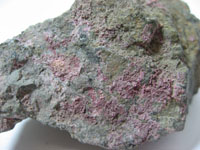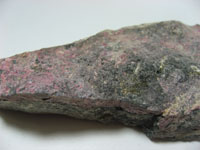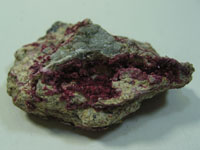![]()
Erythrite is a secondary hydrated cobalt arsenate mineral. Erythrite was first described in 1832 for an occurrence in Grube Daniel, Schneeberg, Saxony,and takes its name from the Greek έρυθρος (erythros), meaning red. Historically, erythrite itself has not been an economically important mineral, but a geologist may use it as a guide to locating associated elements such as cobalt and native silver. Notable localities are Cobalt, Ontario; Schneeberg, Saxony, Germany; Joachimsthal, Czech Republic; Cornwall, England; Bou Azzer, Morocco; the Blackbird mine, Lemhi County, Idaho; Sara Alicia mine, near Alamos, Sonora, Mexico; Mt. Cobalt, Queensland and the Dome Rock copper mine, Mingary, South Australia.
![]()
Within the metaphysical realm of minerals, Erythrite allows for flowing, strong connections between all of a believer's Chakras, bringing the use of loving personal power to the realm of spirituality. It brings harmony in communications and imparts responsiveness, as well as helping the believer to see in many directions and assimilate the knowledge coming from each. Erythrite does contain harmful elements which can be seen in further detail in the 'Health Hazards' section of this article.
Please note that MIROFOSS does not suggest in any way that minerals should be used in place of proper medical and psychological care. This information is provided here as a reference only.
![]() Erythrite is generally used as a collectors mineral and as an identifier for cobalt and silver.
Erythrite is generally used as a collectors mineral and as an identifier for cobalt and silver.
![]()
Erythrite is a secondary mineral in cobalt-bearing deposits.
![]()
Erythrite occurs as a secondary mineral in the oxide zone of Co–Ni–As bearing mineral deposits. It occurs in association with cobaltite, skutterudite, symplesite, roselite-beta, scorodite, pharmacosiderite, adamite, morenosite, retgersite, and malachite. The nickel variety, annabergite, occurs as a light green nickel bloom on nickel arsenides. In addition iron, magnesium and zinc can also substitute for the cobalt position, creating three other minerals: parasymplesite (Fe), hörnesite (Mg) and kottigite (Zn). The colour of erythrite is crimson to pink and occurs as a secondary coating known as cobalt bloom on cobalt arsenide minerals. Well-formed crystals are rare, with most of the mineral manifesting in crusts or small reniform aggregates.
Other than in the basic mineral form, erythrite can be found in one distinct variety:
![]()
| Cleavage | Perfect | |
| Colour(s) | Colourless, Violet red, Light pink, Purple red | |
| Specific Gravity | 3.12 | |
| Diaphaneity | Transparent to Sub transparent | |
| Fracture | Sectile - Curved shavings or scrapings produced by a knife blade | |
| Mohs Hardness | 1.5 to 2.0 | |
| Luminescence | Non-fluorescent | |
| Lustre | Pearly | |
| Streak | Pinkish red | |
| Habit(s) | Divergent to Prismatic to Striated | |
| Radioactivity | Non-radioactive | |
| Magnetism | Non-magnetic |
![]()
The following health hazards should be noted when handling erythrite:
 |
ENVIRONMENTAL HAZARD Erythrite contains the elements Arsenic and Cobalt which are known to cause long term environmental effects. |
 |
TOXIC |
![]()
The following image shows the elemental breakdown of the mineral erythrite along with the mineral crystal structure.
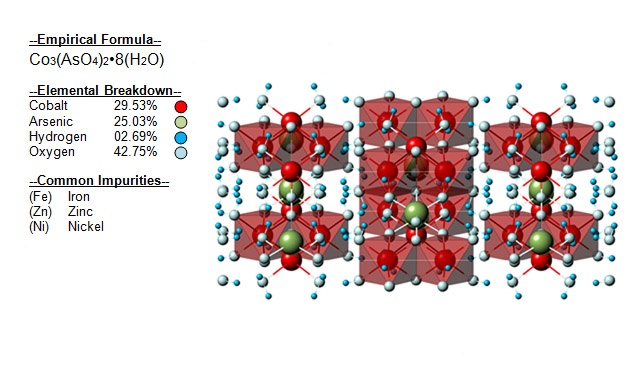
![]()
| Crystal System | Monoclinic |  |
| Class | Prismatic | |
| Axial Ratios | a : b : c = 0.7629 : 1 : 0.3545 | |
| Morphology | Crystals prismatic to acicular and typically flattened; deeply striated or furrowed. Crystals are rare; frequently as radial or stellate groups; globular or reniform shapes with druzy surfaces and columnar or coarse-fibrous structure. Earthy or pulverulent. | |
| Optical Data Type | Biaxial(+) | |
| Pleochroism | Visible | |
| RL Values | nα = 1.626 - 1.629 nβ = 1.662 - 1.663 nγ = 1.699 - 1.701 | |
| 2V | Measured: 85° to 90°, Calculated: 88° to 90° |  |
| Max Birefringence | δ = 0.073 (See colour chart at right) | |
| Surface Relief | Moderate | |
| Comments | May be biaxial negative | |
![]()
Erythrite can be referenced in certain current and historical texts under the following nine names:
The mineral erythrite can be translated into the following select languages:
| Arabic | Bulgarian | Chinese (Sim) | 钴华 | ||
| Croatian | Czech | Danish | |||
| Dutch | Erythriet | Esperanto | Estonian | erütriit | |
| Finnish | erytriitti | French | érythrite | German | Erythrin |
| Greek | Hebrew | Hungarian | Eritrin | ||
| Italian | Eritrite | Japanese | エリトリット | Korean | 요르맆라읻 |
| Latin | Cobalti minera colore rubro | Lithuanian | Norwegian | ||
| Persian | اریتریت | Polish | Erytryn | Portuguese | eritrite |
| Romanian | Vanadinit | Russian | Эритрин | Slovak | |
| Spanish | Eritrina | Swedish | Koboltbeslag | Tagalog | |
| Turkish | eritrit | Ukrainian | Еритрин | Vietnamese |
![]()
Erythrite can be found in a few select locations around the world. The map below shows major documented concentrations of erythrite:
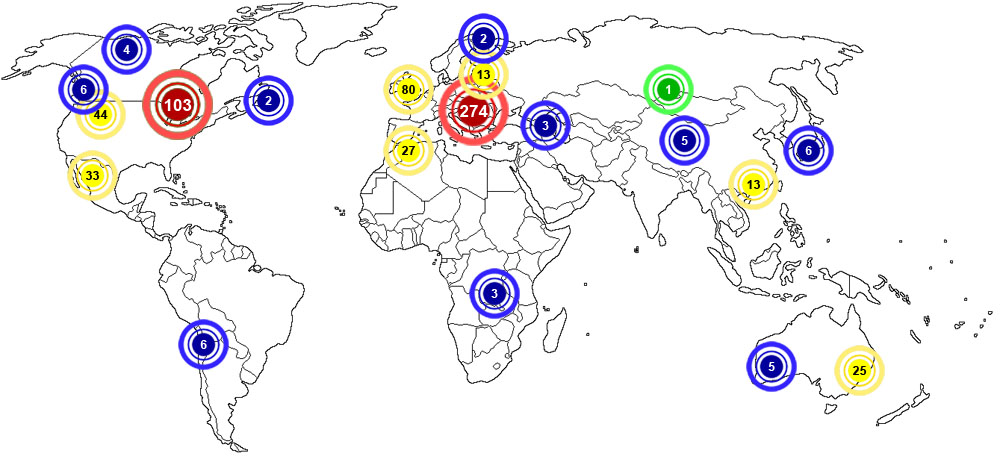

![]()
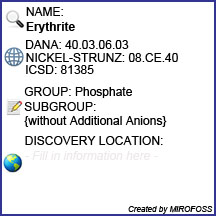 |
The MIROFOSS database offers free printable geological identification tags for personal and non-profit use. These tags can be used to properly identify mineral samples in your collection. -Click here- to download a full size jpeg image for a tantalite identification tag; which can be printed on paper or used with a plastic laser printer. |
 |
What's this? What can I do with it? |
![]()
| Crystallography | Larsen, E.S. and Berman, H. (1934) The Microscopic Determination of the Nonopaque Minerals, Second edition, USGS Bulletin 848: 120, 178. |
| Crystallography | G. H. Faye and E. H. Nickel (1968): The origin of pleochroism in erythrite. Can. Mineral. 9, 493-504. |
| History | Anthony, J.W., Bideaux, R.A., Bladh, K.W., and Nichols, M.C. (2000) Handbook of Mineralogy, Volume IV. Arsenates, Phosphates, Vanadates. Mineral Data Publishing, Tucson, AZ, 680 pp.: 159. |
| History | Wolfe (1940) American Mineralogist: 25: 804. |
| Geographical Data | Mindat.org. Retrieved on 2012-05-30 |
| Physical Identification | Webmineral.com. Retrieved on 2012-05-30 |
| June 25, 2014 | The last time this page was updated |
| ©2018 MIROFOSS™ Foundation | |
 |
|

